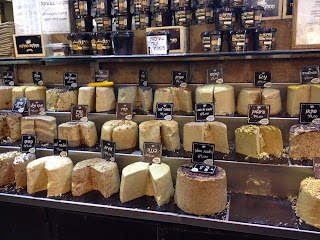Many people thought I was taking a bit of a risk going to Jerusalem, particularly given the problems experienced in the middle of last year in Gaza. However, I figured that the staff at Yad Vashem would give us clear guidelines and do their best to ensure our safety. But I must say, I was rather surprised at just how safe I felt all the time. Our hotel was in a great location- close to the Old City, with all its tantalising little alleys, and different quarters; close to the markets, with their dazzling array of exotic spices and foodstuffs, alongside trendy little restaurants; and minutes away from Mamilla shopping centre for a touch of glamour. We walked everywhere, regardless of the weather, which was a good thing considering the vast quantities of food we seemed to consume everyday. Everyone in the suq was very friendly and bargaining was a lot of fun. Lots of Arab hospitality was on offer - we were always offered a cup of cardamon coffee (so unexpectedly good!) and a lot of banter. We soon became suq rats, easily finding our way around and back to our favourite stalls.
Of course, Jerusalem is known for its holy cites, and it was pretty surreal to be wandering past such landmarks on a regular basis. Religious behaviours are nowhere more apparent than in Jerusalem, with a bewildering array of different types wandering the streets. Juxtaposed with that was going through various checkpoints to ensure that we weren't carrying anything potentially dangerous. We were often accompanied by an armed security guard, which we all thought was a bit amusing, as they seemed to spend most of their time on their phones. Still, I guess when in Rome, etc. Every Israeli has to do military service, girls and boys, and many of them carry rather large weapons around with them all the time, but in the most casual manner. You just get used to that very quickly. Many of the girls look very glam in their uniforms- in a James Bond kind of way.
Our day trips out of Jerusalem were also fascinating, especially going to Masada and the Dead Sea. Each trip deepened our understanding of life in Israel. We drove through the West Bank, surprisingly, and went through a number of checkpoints, where the security seemed pretty bored, until we went up north to the Golan Heights, and one checkpoint there looked like they meant business. Swimming in the Dead Sea was so much fun - I just wish that we had had more time there. Going to the Sea of Galilee was also wonderful- such a beautiful area. Our tour guide was a bit annoying- he felt the need to talk non-stop, and we soon all became experts in drip irrigation.
Anyway, my advice is if you are interested in visiting Israel and are a bit put off by security fears, don't be. It is a spectacular place to visit.






